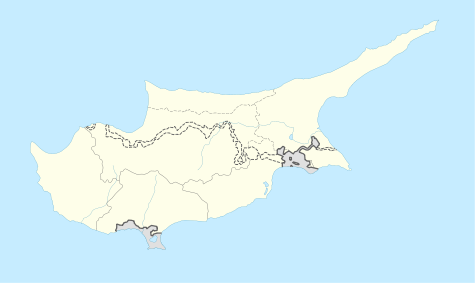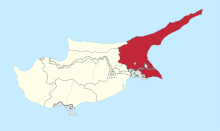Enkomi
| Enkomi | |
|---|---|
 Enkomi Enkomi in Cyprus. | |
| Coordinates: 35°9′30″N 33°53′28″E / 35.15833°N 33.89111°ECoordinates: 35°9′30″N 33°53′28″E / 35.15833°N 33.89111°E | |
| Country |
|
| • District | Famagusta District |
| Country (controlled by) |
|
| • District | Gazimağusa District |
| Population (2011)[1] | |
| • Total | 2,645 |
Enkomi (Greek: Έγκωμη; Turkish: Tuzla) is a village near Famagusta in Cyprus. It is the site of an important Bronze Age city, possibly the capital of Alasiya. Enkomi is under the de facto control of Northern Cyprus.
In 1974, Enkomi had about 800 Greek Cypriot inhabitants. They all fled to the south of the island after the Turkish invasion, in the aftermath of the July coup. As of 2011, Enkomi has a population of 2,645. It comprises displaced Turkish Cypriots from Larnaca and Turkish settlers from Adana Province and Trabzon Province.[2]
History


Enkomi was settled in the Middle Bronze Age, near an inlet from the sea (now silted up). From about the 16th century BC to the 12th, it was an important trading center for copper, which was smelted at the site, with strong cultural links to Ugarit on the facing coast of Syria.
The complicated and badly disturbed stratigraphy of the site has[3] in four major phases, with many subdivisions:
- Level A, a poorly represented preliminary stratum on bedrock;
- Level I, at the beginning of the Late Bronze Age, when fortifications were twice destroyed;
- Level II, with many subdivisions, covering the elaborate expansion of the 14th and 13th centuries and ending in a mass destruction about 1220;
- Level III, with Mycenaean settlers, with a destructive attack often related to the Sea Peoples in IIIA, culturally continuous with IIIB, ending in a destruction about 1125, and IIIC, a final, Mycenaean phase with dwindling population.
During the 13th century BC, Enkomi was inhabited by Greeks, like most of the cities of Cyprus. From the 13th century, other towns along the southern coast of Cyprus competed with Enkomi. After an earthquake ca. 1050 BC, the site was abandoned, leaving an opening for the rise of Salamis.
Alasia
René Dussaud demonstrated that Enkomi is the Alasia of the Amarna correspondence and other texts,[4] including Hittite texts. Long after the town disappeared, Hellenes recalled it in the cult title of Apollo Alasiotas, recorded in a Cypriote inscription as late as the 4th century BC. In 1900 the archaeologist Joseph Offord suggested that Apollo Alasiotas was a Syrian god identical with Resheph, transported to Cyprus,[5] and some modern scholars remain unconvinced.[6] The bronze statuette of a horned god (illustration) may represent this divinity whom Greeks identified, by interpretatio graeca, with Apollo.
Excavation


Following more than a decade of widespread looting drawn by the high quality of the tomb gifts, A. S. Murray worked there for the British Museum in 1894–1896. From the 1930s, excavations were continued by Claude F. A. Schaeffer for the Swedish Cyprus Expedition. Notable finds from Enkomi include Linear C inscriptions and the so-called "horned god",[9] a bronze statuette dated to the early 12th century BC, depicting a deity wearing a horned helmet. Another well-known statue is the "ingot god", a statue wearing a horned conical hat and greaves, armed with shield and spear, and standing on a miniature hide-shaped ingot.
Notes
- ↑ "KKTC 2011 Nüfus ve Konut Sayımı" [TRNC 2011 Population and Housing Census] (PDF) (in Turkish). TRNC State Planning Organization. 6 August 2013.
- ↑ "EKGOMI". Internal Displacement in Cyprus. PRIO Cyprus Centre. Retrieved 15 December 2014.
- ↑ The French excavation report Enkomi-Alasia 1952, and Porphyrios Dikaios, ed. Enkomi Excavations 1948–1958;
- ↑ Dussaud's prefatory note in Enkomi-Alasia: Nouvelles missions en Chypre, Claude F.A. Schaeffer, ed. (Paris, 1952).
- ↑ Joseph Offord, at the First International Congress of the History of Religion, (Paris, 1900) "Apollo Ressef and Apollo Alasiotas", reported by Nathaniel Schmidt, in The Biblical World 16.6 (December 1900:447–450).
- ↑ R.S. Merrillees contended with "a certain pungency" (his expression at the end of his preface, p. 12) for Syria in Alashia Revisited, Cahiers de la Revue biblique 222 (Paris, 1987), which was critically reviewed by Theo P. J. van den Hout, in Journal of Near Eastern Studies 53.2 (April 1994), pp. 138–139.
- ↑ British Museum Collection
- ↑ British Museum Highlights
- ↑ First published in the excavation report ILN 20 and 27 August 1949. The statuette's popular sobriquet, "Apollo Keraiates" ("horned Apollo"), makes an unjustified connection with a later god, known in Arcadia: "A Bronze Age ancestor of the classical Apollo Alasiotas", as J.M. Cook casually put it in passing, in his review of "Archaeology in Greece, 1948–1949" in The Journal of Hellenic Studies 70 (1950. p. 14). "Was the horned god an early Apollo Keraiates from Arcadia, and why was he abandoned, remain among the elusive questions noted by Vronwy Hankey in reviewing Dikaios' excavation volumes in The Journal of Hellenic Studies 95 (1975), p 262. The Apollo designation may be paralleled in the so-called "Venus of Willendorf".
Literature
- Murray, A. S. (1900). "Excavations at Enkomi". In Murray, A. S.; Smith, A. H.; Walters H. B. (eds.). Excavations in Cyprus. London: British Museum.
- Peltenburg, E. J. (1999). "From isolation to state formation in Cyprus: ca. 3500–1500 BC". In Karageorghis, Vassos; Michalides D. (eds.). The development of the Cypriot economy from the prehistoric period to the present day. Nikosia. pp. 17–43.
- Schaeffer, Claude F. A. (1949). Nouvelles découvertes à Enkomi (Chypre). Paris: Académie des Inscriptions et Belles Lettres.
- Schaeffer, Claude F. A. (1952). Enkomi-Alasia I. Paris.
